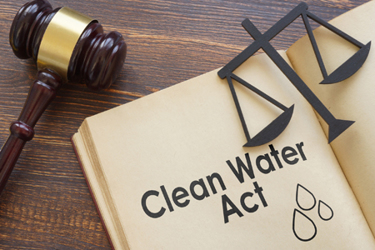Celebrating 50 Years Of (Mostly) Clean Water

By Kevin Westerling,
@KevinOnWater

October 18, 1972, the day the Clean Water Act became law, was undeniably a pivotal moment for the state of water quality in America. From where we stand now, 50 years later, it’s hard to imagine a time when polluters were dumping contaminants freely into environmental waters — enough to set a river on fire!
Many readers will remember the image of Ohio’s Cuyahoga River ablaze on the cover of Time magazine in 1969 — oil slicks, chemicals, tires, and whatever else serving as fuel — and the resulting impact it had as a symbol of pollution and a catalyst for the environmental movement. Soon after, in 1970, the U.S. Environmental Protection Agency (EPA) was created and the first Earth Day was celebrated. Two years later, Congress enacted the Clean Water Act (CWA), which was a renaming of the Federal Water Pollution Control Act of 1948 following the sweeping set of amendments that updated it.
The six key 1972 amendments described in bold below (via EPA.gov) are accompanied by some recent themes that come to mind — mine at least — related to each one, giving current context to the CWA’s stated goals.
Amendment 1: Established the basic structure for regulating pollutant discharges into the waters of the United States.
“Waters of the United States” may sound familiar, as the phrase has been fought over since the Obama administration introduced the “WOTUS” rule in 2015, seeking to expand federal regulatory oversight to systems “connected” to navigable waters, such as streams and wetlands. During the Trump administration, the rule was suspended, repealed, and replaced, but the replacement rule was thrown out in court. Now called the Clean Water Rule, the Biden administration has promised to return the rule to WOTUS circa 2015.
Amendment 2: Gave EPA the authority to implement pollution control programs such as setting wastewater standards for industry.
Per- and polyfluoroalkyl substances (PFAS) weren’t known as contaminants in 1972, but they are found far and wide in 2022. The same can be said for microplastics. While the EPA’s authority “to implement pollution control programs such as setting wastewater standards for industry” has obviously improved water quality — no more rivers on fire — industrial processes have still polluted the environment in less obvious but extremely pervasive ways.
Amendment 3: Maintained existing requirements to set water quality standards for all contaminants in surface waters.
Unfortunately, when I think of surface waters and water quality today, an image of harmful algal blooms appears — HABs, for short — so named because of the toxic cyanobacteria within them that can kill fish and other aquatic species, even pets, and have serious deleterious effects in humans. The questions of where and how to adequately prevent, control, and ultimately remediate HABs continue to plague municipalities.
Amendment 4: Made it unlawful for any person to discharge any pollutant from a point source into navigable waters, unless a permit was obtained under its provisions.
“Navigable waters” reminds me of County of Maui v. Hawai’i Wildlife Fund, which Earthjustice described as the “Clean Water Case of the Century.” The 2020 verdict established that point-source discharges “into navigable waters, or when the discharge reaches the same result through roughly similar means” [emphasis mine], can be regulated under the Clean Water Act. The “similar means” in the case against the County of Maui was through groundwater, establishing that this is no buffer to regulatory relief.
Amendment 5: Funded the construction of sewage treatment plants under the construction grants program.
The 1972 amendment that provided funding for construction of wastewater treatment plants (WWTPs) — or what many now call water resource recovery facilities (WRRFs) — is now 50 years old, which means that many of the facilities constructed in its wake are beyond useful life. Infrastructure renewal got a boost with the recent Infrastructure Investment and Jobs Act (IIJA), but the needs still outweigh funds.
Amendment 6: Recognized the need for planning to address the critical problems posed by nonpoint source pollution.
While I can’t speak to what lawmakers and the nascent environmental movement were specifically wary of back then, today’s nonpoint source pollution issues seem largely due to agricultural runoff — a main cause of HABs — and stormwater management, including the prevention of sewer overflows.
Fifty years of great progress, but water work is never done!
